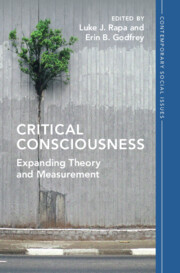Book contents
- Critical Consciousness
- Contemporary Social Issues
- Critical Consciousness
- Copyright page
- Dedication
- Contents
- Figures
- Tables
- Contributors
- Acknowledgments
- Introduction Critical Consciousness Theory and Measurement
- Part I Theory
- 1 Synthesizing Critical Consciousness and Identity-Based Motivation to Clarify How Youth of Color Navigate and Challenge Racial Capitalism
- 2 Situating Critical Consciousness Within the Developmental System
- 3 Integrating Critical Consciousness and Social Empathy
- 4 Critical Consciousness in Early to Middle Childhood
- 5 Adolescents’ Developmental Pathways to Critical Consciousness in the Contexts of Racial Oppression and Privilege
- 6 Making Reflection Critical
- Part II Measurement
- Conclusion Expanding Critical Consciousness Theory and Measurement
- Index
- References
1 - Synthesizing Critical Consciousness and Identity-Based Motivation to Clarify How Youth of Color Navigate and Challenge Racial Capitalism
from Part I - Theory
Published online by Cambridge University Press: 20 April 2023
- Critical Consciousness
- Contemporary Social Issues
- Critical Consciousness
- Copyright page
- Dedication
- Contents
- Figures
- Tables
- Contributors
- Acknowledgments
- Introduction Critical Consciousness Theory and Measurement
- Part I Theory
- 1 Synthesizing Critical Consciousness and Identity-Based Motivation to Clarify How Youth of Color Navigate and Challenge Racial Capitalism
- 2 Situating Critical Consciousness Within the Developmental System
- 3 Integrating Critical Consciousness and Social Empathy
- 4 Critical Consciousness in Early to Middle Childhood
- 5 Adolescents’ Developmental Pathways to Critical Consciousness in the Contexts of Racial Oppression and Privilege
- 6 Making Reflection Critical
- Part II Measurement
- Conclusion Expanding Critical Consciousness Theory and Measurement
- Index
- References
Summary
This chapter applies critical consciousness and identity-based motivation theories to understand youth of color’s psychological experiences in the face of oppression and the processes by which they can negotiate and challenge their conditions. Critical consciousness and identity-based motivation theories explicate how inequality shapes psychological processes and how these processes can either perpetuate or serve to challenge inequality. We also draw on the framework of racial capitalism – which posits that contemporary global capitalism emerged out of racial hierarchy – to contextualize the barriers youth of color traverse in their pursuit of social mobility. A racial capitalism analysis highlights the injustices youth of color contend with. We first provide overviews of the context of racial capitalism, identity-based motivation, and critical consciousness independently, and then we highlight the overlap between identity-based motivation and critical consciousness within the context of US racial capitalism. This synthesis helps to clarify how youth experience and navigate injustice by leveraging insights from both identity-based motivation and critical consciousness to illuminate the mechanisms that either thwart or promote their healthy development.
Keywords
- Type
- Chapter
- Information
- Critical ConsciousnessExpanding Theory and Measurement, pp. 19 - 40Publisher: Cambridge University PressPrint publication year: 2023

